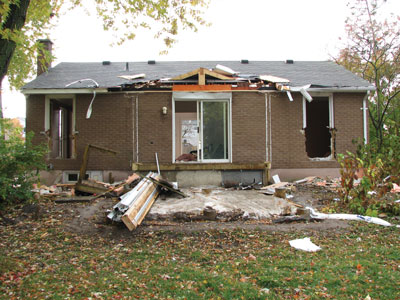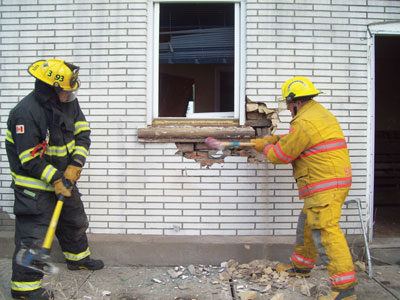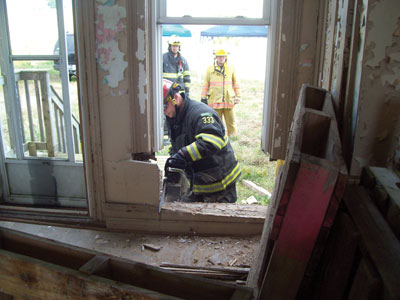
Back to Basics: January 2012
Mark Van
Features Fire Ground TrainingRemoving the mayday firefighter from a hostile environment is a top priority for the rapid intervention team (RIT) operation.
Removing the mayday firefighter from a hostile environment is a top priority for the rapid intervention team (RIT) operation. Incident commanders and RIT operations officers need to address this issue when planning an exit strategy. When RIT members conduct their initial nine-step assessment of the mayday firefighter, the RIT officer should start planning for a quick exit by sizing up the environment and the situation. As mentioned in the column on nine-step assessment in July 2011, if the mayday firefighter is not breathing, then a grab-and-go operation to the nearest exit must take place as it is vital to get the mayday firefighter out to receive immediate medical attention.
The environment will dictate what actions you can take as far as an exit strategy is concerned. Some environmental factors may include:
- partial collapse
- untenable heat conditions
- explosion
- rapid increase in fire conditions
- backdraft/flashover
These situational and environmental factors may require RIT members to use an exit point other than the initial entry point. This can be accomplished by enlarging existing openings such as windows and doorways to make them into sufficient exit points.
 |
 |
| Photo 1: The back of a house with two enlarged openings made from existing windows. Advertisement
|
Photo 2: Two firefighters with mauls remove the brick face to expose the interior wood wall.
|
Most rooms in residential buildings have windows that can be converted into doorways to provide a way out. This may not be the case in a commercial or industrial building. Instead, firefighters may need to breach a wall to convert it into an exit.
Doors in structures can be widened to quickly remove a larger-sized firefighter. Door width varies and can sometimes impede the RIT from efficiently extricating the mayday firefighter.
Enlarged openings are usually created from the exterior side of the building, but sometimes openings will need to be made from inside to accommodate the RIT operation. This would be the case in a situation in which there are multiple rooms between the exterior wall and the mayday firefighter, requiring the interior walls to be breached and made into doorways to provide a direct pathway to the mayday firefighter or to allow him to be transferred from one room to another because of safety concerns.
Enlarged openings also provide a quick way for RIT members to enter the structure. In fire-ground operations, we usually think about enlarged openings when considering a way out of the building, but enlarged openings can also provide a quicker way in. Doing so requires that RIT members know the location of the mayday firefighter, either through radio reports from the firefighter, through last-known location from accountability, or from homing in on the sound from the PASS device.
Regardless of what type of enlarged opening you are going to make, safety needs to be a priority for the team assigned to the task. A separate team should be assigned to create the opening so RIT members can continue with the assessment, packaging and removal of the mayday firefighter. A safety officer should be assigned to oversee the cutting operations to reduce any chance of injury from moving machine parts or hand tools. The safety officer can be stationed either inside or outside (or, if available, have one safety officer inside and one safety officer outside). Communication between the inside crews and outside crews will be key to avoid injuries from chainsaws, circular saws or hand tools.
Tools that can be used for creating an enlarged opening are:
- chainsaw
- circular saw
- sawzalls
- mauls
- Halligans
- pike poles/roof hooks
- hydraulic cutters
Photo 2 (page 14) shows a residential structure that has a brick face on the outside and is protecting the wood structure inside. Two firefighters are using mauls to easily remove the brick. The firefighters are positioned on either side of the window and will work in tandem by swinging in alternating synchronization to break the brick. As long as the tandem team works diligently and consistently, the rest of the operation will flow smoothly once the first few bricks are broken.
 |
 |
| Photo 3: The interior wood wall is exposed and ready to be cut using a chainsaw.
|
Photo 4: Another firefighter finishes enlarging the opening using a chainsaw. Photos by Mark van der Feyst
|
When the firefighters are done, the inside wall will be exposed, as shown in photo 3 (page 14). This allows another firefighter to use a chainsaw to finish the cutting operation, turning the window into a doorway. In photo 4 (page 14), the firefighter is completing the cutting operation. A safety officer needs to be positioned inside the structure to co-ordinate the operation with the interior crews. The chain of the chainsaw will easily cut through fire gear, skin and bones if attention and distance are not maintained between the cutting operation area and the interior crews. The use of chainsaws or circular saws powered by gasoline engines is most effective when used outside the structure, as firefighters will need fresh air to operate and visibility to see what they are cutting.
Once the opening has been made, ensure that most of the debris is removed from the exit opening to reduce the chance of trip hazards, obstructions or entanglement hazards for the RIT members.
The enlarged opening shown here is a window with the sides cut down to the bottom of the wall, making the window into a door. A door or a window can be extended on the bottom to make it wider for ease of removal. This will require the door or window to be cut horizontally, halfway over (about three feet), and then vertically down to the bottom. In the end you will have an L-shaped opening, allowing a stokes basket or sked to be removed without any interference from the building.
We have focused on first-floor applications for enlarged openings. These are the easiest enlarged openings to create, but enlarged openings can also be created on second storeys. This involves more co-ordination between inside and outside crews and it requires outside crew members to use ground ladders. This type of operation also requires support personnel on the ground using pike poles to prevent the cut section of wall from falling down to the ground uncontrollably.
Practice and training on these options will enhance the RIT’s ability to quickly and efficiently extricate a mayday firefighter.
Mark van der Feyst is a 13-year veteran of the fire service. He currently works for the City of Woodstock Fire Department in Ontario. Mark is an international instructor teaching in Canada, the United States and India. Mark is a local-level suppression instructor for the Pennsylvania State Fire Academy, and an instructor for the Justice Institute of British Columbia. He can be contacted at Mark@FireStarTraining.com
Print this page